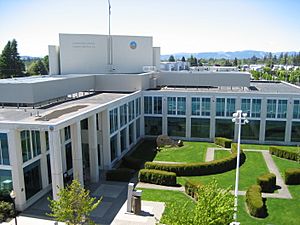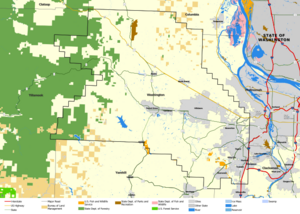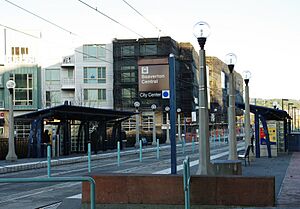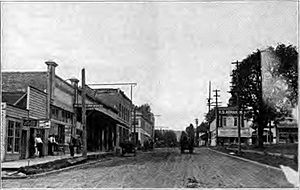Washington County, Oregon facts for kids
Quick facts for kids
Washington County
|
||
|---|---|---|
|
From top, left to right: Washington County courthouse, Meier Road Barn, a canola field in rural Washington County
|
||
|
||

Location within the U.S. state of Oregon
|
||
 Oregon's location within the U.S. |
||
| Country | ||
| State | ||
| Founded | July 5, 1843 (as Twality District) | |
| Named for | George Washington | |
| Seat | Hillsboro | |
| Largest city | Hillsboro | |
| Area | ||
| • Total | 726 sq mi (1,880 km2) | |
| • Land | 724 sq mi (1,880 km2) | |
| • Water | 2.2 sq mi (6 km2) 0.3% | |
| Population
(2020)
|
||
| • Total | 600,372 | |
| • Estimate
(2023)
|
598,865 |
|
| • Density | 827.0/sq mi (319.29/km2) | |
| Time zone | UTC−8 (Pacific) | |
| • Summer (DST) | UTC−7 (PDT) | |
| Congressional districts | 1st, 6th | |
Washington County is one of 36 counties in the state of Oregon. It is part of the larger Portland metropolitan area. In 2020, about 600,372 people lived here. This makes it the second most populated county in Oregon. It is also the most populated "Washington County" in the United States.
Hillsboro is the main city and the county seat. Other important cities include Beaverton, Tigard, and Forest Grove. Forest Grove is the oldest city in the county. The county was first called Twality when it was created in 1843. In 1849, it was renamed after George Washington, the first president of the United States.
The Tualatin River flows through most of the county. The county is surrounded by mountains. These include the Northern Oregon Coast Range to the west and north, the Chehalem Mountains to the south, and the Tualatin Mountains (West Hills) to the north and east.
Major roads like Interstate 5 and 205 run through the county. Public transportation is mainly provided by TriMet. This includes buses, the Westside Express Service train, and MAX Light Rail. You can also find air travel at Hillsboro Airport.
Contents
History of Washington County
Washington County was created on July 5, 1843. It was first known as the Twality District. It was one of the first four districts of the Provisional Government of Oregon. The other three were Clackamas, Champooick (now Marion), and Yamhill counties.
In 1850, Columbia (now Hillsboro) became the county seat. Washington County lost some of its land in 1854. This happened when Columbia and Multnomah counties were formed. Later, in 2014, a small part of Multnomah County was added back to Washington County. This helped with property development.
Building Canyon Road to Beaverton was important. It helped Portland become the main port in Oregon. This made Portland more important than other towns like Oregon City.
In 2004, Washington County and the city of Beaverton made a plan. Beaverton wanted to add nearby neighborhoods to its city limits. These areas included Cedar Hills and Aloha. However, these plans were stopped later on.
Geography of Washington County
Washington County covers about 726 square miles. Most of this is land, with a small amount of water. It is located about 20 miles west of Portland.
Most of the county is in the Tualatin Valley. This valley is surrounded by mountains. The Tualatin Mountains are to the east and north. The Chehalem Mountains are to the south. The Northern Oregon Coast Range is to the west and north. The Tualatin River flows through the valley. The northern and western parts of the county have many forests. Other parts have cities, farms, and floodplains. The highest point in the county is South Saddle Mountain. It is 3,464 feet above sea level.
Waterways in Washington County
The Tualatin River is the main river in Washington County. Henry Hagg Lake, near Forest Grove, is the largest lake. The Willamette River is to the east. The Columbia River is to the northeast. The Pacific Ocean is to the west.
Neighboring Counties
- Clatsop County - northwest
- Columbia County - north
- Multnomah County - east
- Clackamas County - southeast
- Yamhill County - south
- Tillamook County - west
Main Roads in Washington County
 Interstate 5
Interstate 5 Interstate 205
Interstate 205 U.S. Route 26
U.S. Route 26 Oregon Route 6
Oregon Route 6 Oregon Route 8
Oregon Route 8 Oregon Route 10
Oregon Route 10 Oregon Route 47
Oregon Route 47 Oregon Route 99W
Oregon Route 99W Oregon Route 210
Oregon Route 210 Oregon Route 217
Oregon Route 217 Oregon Route 219
Oregon Route 219
Protected Natural Areas
Airports in Washington County
- Apple Valley Airport
- Bernard's Airport
- Hillsboro Airport
- Skyport Airport
- Stark's Twin Oaks Airpark
- Sunset Air Strip
Population Facts
| Historical population | |||
|---|---|---|---|
| Census | Pop. | %± | |
| 1850 | 2,652 | — | |
| 1860 | 2,801 | 5.6% | |
| 1870 | 4,261 | 52.1% | |
| 1880 | 7,082 | 66.2% | |
| 1890 | 11,972 | 69.0% | |
| 1900 | 14,467 | 20.8% | |
| 1910 | 21,522 | 48.8% | |
| 1920 | 26,376 | 22.6% | |
| 1930 | 30,275 | 14.8% | |
| 1940 | 39,194 | 29.5% | |
| 1950 | 61,269 | 56.3% | |
| 1960 | 92,237 | 50.5% | |
| 1970 | 157,920 | 71.2% | |
| 1980 | 245,808 | 55.7% | |
| 1990 | 311,554 | 26.7% | |
| 2000 | 445,342 | 42.9% | |
| 2010 | 529,710 | 18.9% | |
| 2020 | 600,372 | 13.3% | |
| 2023 (est.) | 598,865 | 13.1% | |
| U.S. Decennial Census 1790–1960 1900–1990 1990–2000 2010–2020 |
|||
In 2010, there were 529,710 people living in Washington County. There were about 200,934 households. Most people (76.6%) were white. About 8.6% were Asian, and 1.8% were Black. About 15.7% of the population was of Hispanic or Latino background. The average age of people living in the county was 35.3 years old.
Economy of Washington County
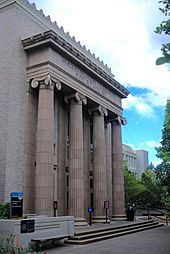
Washington County has rich farmland. This attracted farmers a long time ago. Farming is still a big industry here. Other important industries include lumber, making goods, and food processing.
In the 1980s and 1990s, a large electronics industry grew in the county. This led to the area being called Oregon's Silicon Forest. Many big technology companies are located here. Intel, a very large computer chip company, has its biggest offices in Hillsboro. Other tech companies like Tektronix and EPSON are also in the county.
Nike, a famous sports company, has its main headquarters in Washington County. Other companies with headquarters here include Columbia Sportswear (clothing) and Reser's Fine Foods (food products).
Communities in Washington County
Cities in Washington County
| City | 2020 population | 2010 population | 2000 population | 1990 population | Incorporated | Notes |
|---|---|---|---|---|---|---|
| Banks | 1,837 | 1,777 | 1,286 | 563 | 1921 | |
| Beaverton | 97,494 | 89,803 | 76,129 | 53,310 | 1893 | |
| Cornelius | 12,694 | 11,869 | 9,652 | 6,148 | 1893 | |
| Durham | 1,944 | 1,351 | 1,382 | 748 | 1966 | |
| Forest Grove | 26,225 | 21,083 | 17,708 | 13,559 | 1872 | |
| Gaston | 676 | 637 | 600 | 563 | 1914 | |
| Hillsboro | 106,447 | 91,611 | 70,187 | 37,520 | 1876 | County seat |
| King City | 5,184 | 3,111 | 1,949 | 2,060 | 1966 | |
| Lake Oswego | 40,731 | 36,619 | 35,278 | 30,576 | 1910 | Small portion, most in Clackamas County |
| North Plains | 3,441 | 1,947 | 1,605 | 972 | 1963 | |
| Portland | 652,503 | 583,776 | 529,121 | 437,319 | 1851 | Small portion, most in Multnomah County |
| Rivergrove | 545 | 289 | 324 | 294 | 1971 | Small portion, most in Clackamas County |
| Sherwood | 20,450 | 18,194 | 11,791 | 3,093 | 1893 | |
| Tigard | 54,539 | 48,035 | 41,223 | 29,344 | 1961 | |
| Tualatin | 27,942 | 26,054 | 22,791 | 15,013 | 1913 | |
| Wilsonville | 26,664 | 19,509 | 13,991 | 7,106 | 1969 | Small portion, most in Clackamas County |
Census-Designated Places
These are areas that are like towns but are not officially incorporated as cities.
Unincorporated Communities
These are smaller communities that are not part of any city.
- Bacona
- Balm Grove
- Blooming
- Bonita
- Bonny Slope
- Bradley Corner
- Buckheaven
- Buxton
- Carnation
- Chehalem
- Christie
- Detour
- Dilley
- Dixie
- Elmonica
- Farmington
- Gales Creek
- Glencoe
- Glenwood
- Greenville
- Hayward
- Hazeldale
- Helvetia
- Hillside
- Huber
- Kansas City
- Kinton
- Laurel
- Laurelwood
- Manning
- Meacham Corner
- Middleton
- Midway
- Mountaindale
- Mulloy
- Nasoma
- Norwood
- Patton
- Reedville
- Roy
- Scholls
- Seghers
- Six Corners
- Somerset West
- Stimson Mill
- Tanasbourne
- Thatcher
- Tillamook Junction
- Timber
- Tobias
- Tophill
- Trece
- Verboort
- Watts
- West Union
- Wilkesboro
- Witch Hazel
See also
 In Spanish: Condado de Washington (Oregón) para niños
In Spanish: Condado de Washington (Oregón) para niños






